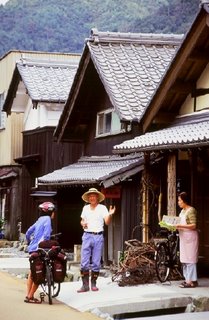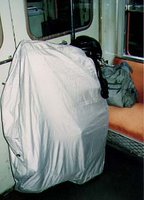 In the comments to the last post, about Honjo fenders, Ernesto mentions "Rinko". This is the Japanese term for travelling on a train with your bike in order to reach a cycling destination.
In the comments to the last post, about Honjo fenders, Ernesto mentions "Rinko". This is the Japanese term for travelling on a train with your bike in order to reach a cycling destination.As I scheme about a trip to Japan I am looking forward to trying rinko. The basic idea is that if you put your bike in a "rinko-bukhuro" (a lightweight nylon bike bag) you can take it with you in the passenger compartment of a Japanese train. Since Japanese trains are fast, punctual, and plentiful, this seems a fantastic way to tour various areas of the country in one visit.
I understand that, once out of the big cities, cyclo-touring Japan can be surprisingly affordable and friendly.
The superb Japan Cycling Navigator site has good instructions for packing your bike for train travel as well as routes and general information on cyclo-touring in Japan.The photo on the left is from this site:
http://www.japancycling.org/v2/info/rinko/rinko.shtml
Here is a great page about rinko-bukhuros and their use: http://www.kancycling.com/GettingStarted/UsingBikebags/Bikebag.html
This is a photo of a Toei "Rinko Randonneur". I'm not sure why this bike, which has no special rinko-friendly features, bear this title: http://members.aol.com/SatoruMas/mybike/randonne.html
This demontableToei might be a better choice.
And this site has a fantastic collection of "touring reports" in Japanese, but with Google language tools that's not a huge issue: http://www5e.biglobe.ne.jp/~akuta/touring-report%20index.html
The Outdoor Japan page listing cycling terminals; these are a sort of hostel for cyclo-tourists: http://www.outdoorjapan.com/activities/cycling/activities-cycling-terminals

Perhaps Ernesto, or someone else who has toured in Japan, will chime in with further information. Anyone else interested in touring Japan by train and bike?
By the way, if you use Mozzila Firefox, and you really should, there is an amazing free extension called FoxLingo that allows you to translate almost any web page into English with two mouse clicks. I don't know how I lived without it.

The Toei demountable: GOSH.
ReplyDeleteAll of the functionally of the French bikes with the finish elevated to, dare I say, perfection? I noticed the quick release on the stem so the fork is removable, as well as the more expected split at the BB, etc. It's just stunning.
I think that Rinko Randonneur is the most beautiful cycle I have ever seen. Wow.
ReplyDeleteThe bike the demontable Toei's owner links to is also interesting and might make a fine rinko mount.
ReplyDeleteAlso, I have translated that page using three diffrent translation engines and the owner calls his bike "demon tar bull". Anyone know what this means?
Google brings up a link to "Mistress Rinko". This turns out NOT be the web site of a young cycletouring enthusiast (not work safe).
ReplyDelete"demon tar bull" -- Demontable.
ReplyDeleteNeat, neat bikes in any language.
John
Some things in life a matter of taste. Other things are absolute. The Demon Tar Bull is absolutely and obviously the most beautiful bicycle. Anyone who thinks otherwise is probably a beer-swilling NASCAR fan.
ReplyDeletePleeese, don't take this too seriously.
I can't see the image load in my browser at work. However, I wonder if a Ritchey breakaway system might be a nice way to create a Rinko bike?
ReplyDeleteI've seen a few bikes(non-demontable) that even have fender separation capability, complete with QR eyelet security.
ReplyDeletehttp://campagnolo.cocolog-nifty.com/blog/2006/05/post_3d6f.html#comments
This way the bike is broken down without removing the entire rear fender that would otherwise extend far from the frame. Can you quess what that orange bike is?
There is a blog run by a keen cyclist who lives in Japan under http://japanlost.blogspot.com/
ReplyDeleteit can vary from positive to negative depending on how the writer is feeling, but it has a load of interesting anecdotes and stories about cycling there, including the apparently suicidal tendencies of pedestrians in towns, which I can confirm. Also most motorists don't know what to do when confronted by a bike, so they tend to just charge at you and assume you'll get out of the way. Mind you, bikes can turn up on the left, right and middle of the road, in either direction and in the dark with no lights so it cuts both ways. That said, with a good map and a sense of adventure you can reach outback really fast, and the trains are safe and plentiful, although I'd be interested to see how you ger a bike through the ticket barrier in or out of a bag...
I think my current favorite site is cyber cyclist's:
ReplyDeletehttp://cchp.dion.jp/
Almost all of his trips are rinko, wth excellent google maps of the routes, and many, many photos, which often include the starting and stopping stations.
I like the way the translators call randonneur - run donor.
I'm ready to go back to Japan. All that is holding me back is time and money. When do we leave?
One thing I am wondering is why these Rinko fellas bother with fenders at all ... this Rinko thang sounds kinda cool, but fenders would just seem to make it infinitely more complicated. Or just use the flexible plastic fenders and not worry about it. I mean, I like the metal full-length fenders as much as the next guy, but why beat your head against the wall?
ReplyDeleteAs an aside: doggone do those Toei guys have it licked. Never seen a Toei in person, but it just looks like truly *stellar* craftsmanship and a keen eye for proportion and rightness.
I have several bikes, including a 650B and an S&S Coupled Travel bike, but sometimes I like to ponder the question: What if I could only have one bike? Could I do it? What would it be? I think You've shown me the answer: The Toei demountable!!!
ReplyDeleteWow.
Let see...I can sell all my bikes, study Japanese, take all of next summer off, go to Japan, get custom Toei, spend 3-months Rinko Randonnering and Pass Hunting! Oh Yes!
My friend developed an innovative RINKO system.
ReplyDeleteWatch this video!